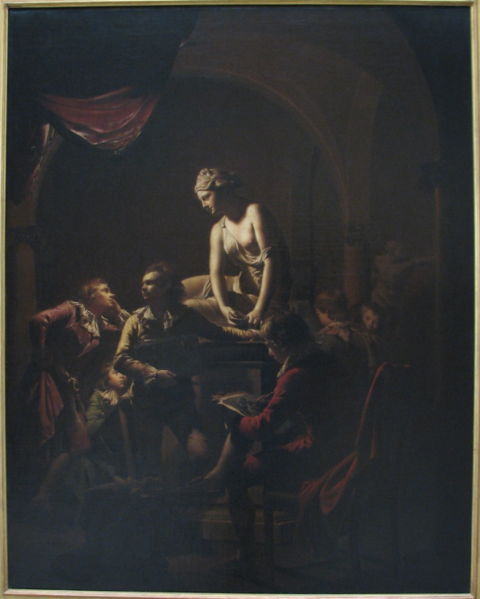In anticipation of this year’s Royal Academy Summer Exhibition, which opens to the public on Tuesday, today’s picture is Joseph Wright of Derby’s An Academy by Lamplight. It was painted in 1768, the year of the Royal Academy’s foundation, and may fairly be regarded as a textbook illustration of the values which Britain’s oldest art institution was originally formed to protect, promote and inculcate.
In a vaulted sculpture gallery six young men are gathered before the statue of an enigmatically smiling, scantily dressed classical goddess. They pay her varying degrees of attention which range from solemn studiousness to sleepy indifference. One of them, leaning against the statue’s plinth, head propped on his elbow, has a dreamy, amorous look in his eyes. Beside him, a rather older man with receding hair gazes away into the middle distance, a high-minded expression on his face. Holding a portfolio under his arm, he has the air of an enthusiastic and slightly abstracted teacher. Perhaps he is the boys’ tutor.
The first academies of art had been established during the Renaissance, in Italy, but the eighteenth century brought a sudden exponential growth in the number of such institutions. They came into being all over Europe: in Copenhagen, Stockholm, St Petersburg, Dresden, Naples, Venice, Dijon and Valencia; and as far afield as Mexico, where an Academy of Fine Arts was founded in 1785. One reason for this was the increasing desire of artists everywhere to be recognised as members of a liberal and literate profession – one which demanded intellectual discipline and specialised knowledge of its practitioners, not just the manual skills of an artisan.
By the time Wright painted An Academy by Lamplight, the prescribed course of academic study for would-be artists was well established. First, the student was to make drawings of...

ITP 59: An Academy by Lamplight, Joseph Wright of Derby
03-06-2001

